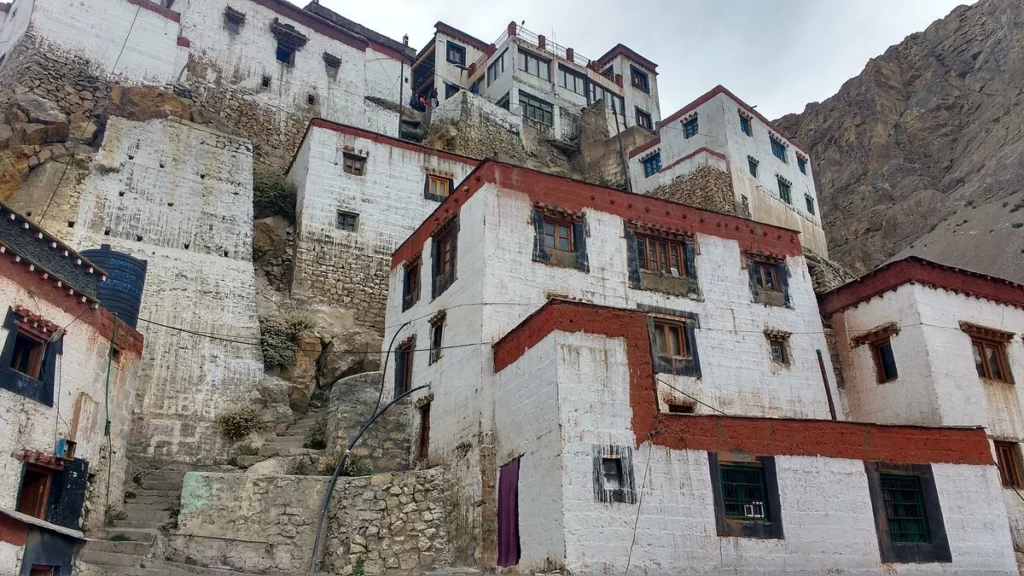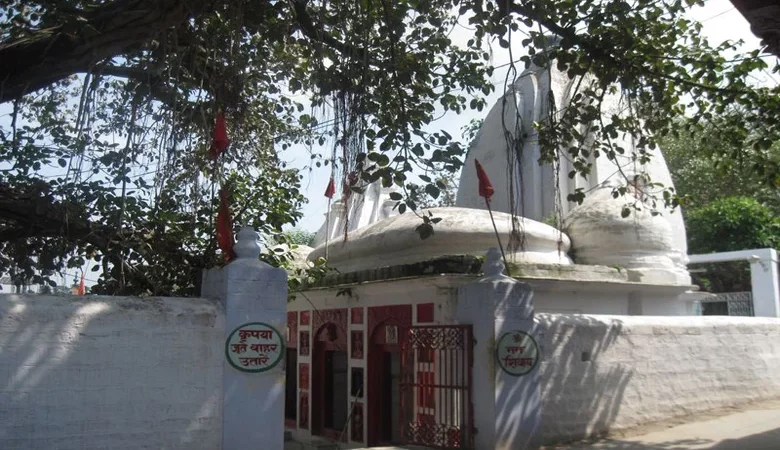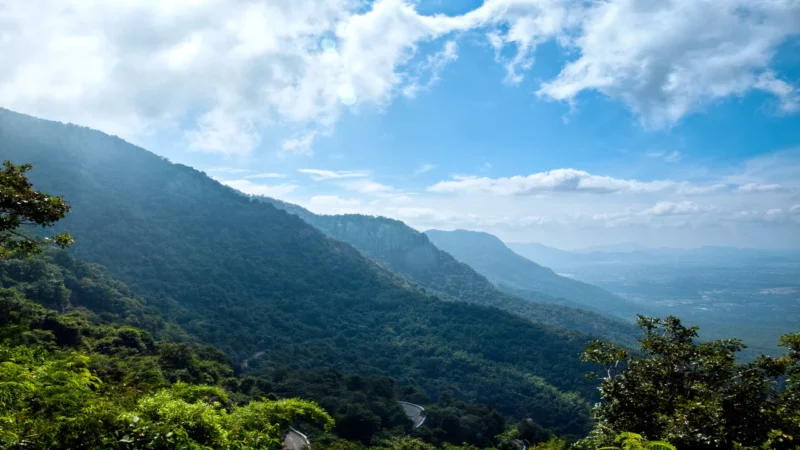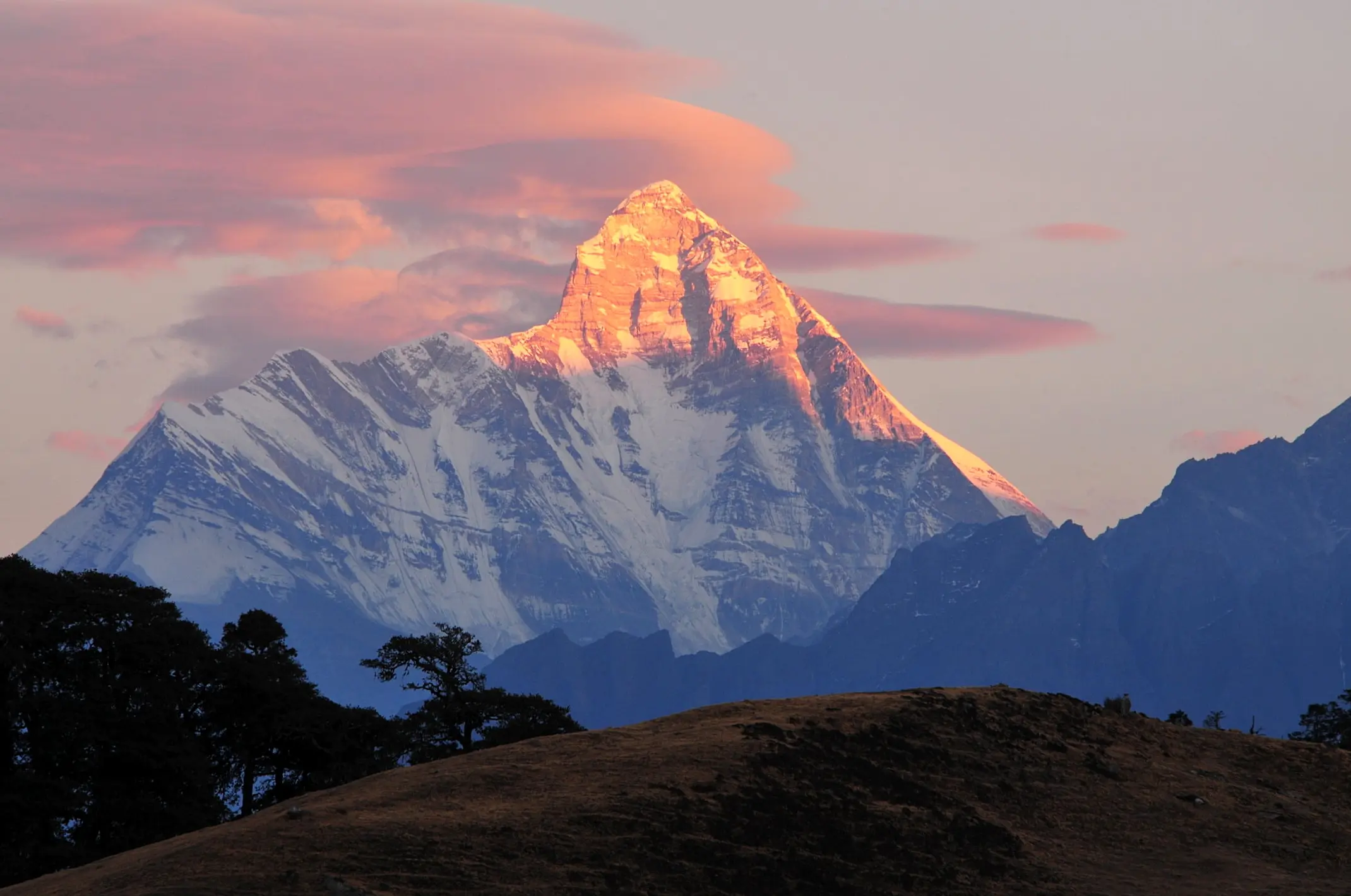Key Monastery, also known as Kye Gompa, (spelled Ki, key, Kye, or Kee) of the Gelugpa sect. is a Tibetan Buddhist Monastery, well known for being one of the largest monasteries in Spiti Valley, situated on a picturesque hilltop at an altitude of 4,166 m (13,668 ft) above sea level, close to the River Spiti, in Spiti Tehsil of Lahaul and Spiti district, in the state of Himachal Pradesh. The word “Spiti” means “The middle land“, i.e., the land between India and Tibet. As many people know that the geographic conditions of the land are described as the cold desert mountain valley. Kaza or Kaze is the subdivisional headquarters of this quaint Village, Key (or) Kye. This Monastery is not only a spiritual training center for Lamas but also home to around 300 lamas who receive their spiritual training here. The spiritual training provided in the monastery entails singing, dancing, and playing with their pipes and horns. Inside the monastery, you can witness rare paintings and beautiful scriptures of Buddha and other gods & goddesses. This place is home to cave-like rooms facing the mountains, where you can spend some time meditating.
The Key monastery also known as Kye Gompa is a famous Tibetan Buddhist Monastery and one of the must-visit places in Spiti, Himachal Pradesh. This monastery draws visitors from all over the world and is one of the most popular attractions in Spiti valley that almost everyone who comes to this way visits. The Key monastery is not only the biggest but also the oldest one in Spiti valley. Surrounded by snow-capped mountains and glaciers, the beauty of the valley is breathtaking and the route to Key Monastery is also beautiful. The culture of Spiti village closely resembles Tibet and it's hardly surprising that Spiti is known as Little Tibet. This Key Monastery draws a large number of pilgrims during its annual festival - Cham (masked and costume dance), performed by the lamas, held every year in June or July (the tenth month in the Tibetan calendar)) is very popular and the theme of the event emphasizes the victory of good over evil. As a part of the ritual, the devotees from neighboring villages who have come to attend the festival lay themselves down on the ground so that the lamas can walk over them.
History of Key Monastery
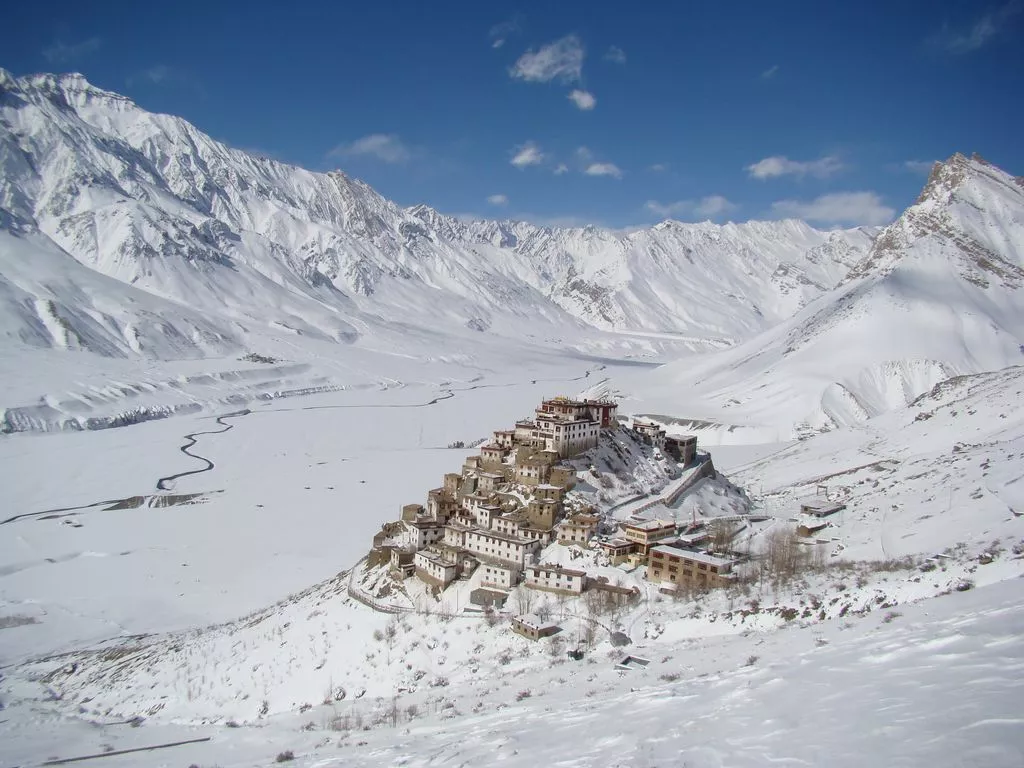 It’s hard to believe that the Key Monastery is over 1000 years old and is a spiritual training center for Lamas. The exact year of this magnificent Key Gompa’s (Key Monastery) founding is still unknown but it is believed to have been founded in the 11th century by Dromtön (1005-1064), a student of the famous Buddhist master, Atiśa Dīpaṃkara Śrījñāna, the creator of the Kadam school of Tibetan Buddhism and the founder of Reting Monastery. Key Gompa, belongs to the Gelugpa sect. also called the Yellow Hat sect. of Tibetan Buddhism. Key Monastery has been destroyed by invaders and rebuilt several times. In the 14th century, when the Sakya sect. rose to power the nearby villages have been destroyed with Mongol assistance. During the timeline of the 5th Dali Lama, the Kye was attacked again by the Mongols. Kye Monastery was sacked yet again during the war between Ladakh and Kullu in 1830 and 1840 CE, Disaster struck the monastery yet again when the structure was damaged by fire. In 1841, under the rule of Ghulam Khan and Rahim Khan of the Dogra army, the monastery was severely damaged, and later that year, it was attacked again by the Sikh regiment. In 1975, it suffered extensive damage due to a massive earthquake. The Archaeological Survey of India along with the help of the State Public Works Department, worked to repair and restore this historic structure. Having been destroyed and rebuilt several times, the Kye Monastery still retained its beauty. The celebration of its millennium was conducted in the year 2000 in the presence of the Dalai Lama. A new prayer hall was inaugurated by the 14th Dalai Lama (known as Gyalwa Rinpoche) and over 1500 devotees from all over the world, attended this Kalachakra ceremony, which was on 03 August 2000. The primary focus of the ceremony was on five main subjects namely cosmology, psycho-physiology, initiation, sadhana (study), and attaining Buddhahood.
It’s hard to believe that the Key Monastery is over 1000 years old and is a spiritual training center for Lamas. The exact year of this magnificent Key Gompa’s (Key Monastery) founding is still unknown but it is believed to have been founded in the 11th century by Dromtön (1005-1064), a student of the famous Buddhist master, Atiśa Dīpaṃkara Śrījñāna, the creator of the Kadam school of Tibetan Buddhism and the founder of Reting Monastery. Key Gompa, belongs to the Gelugpa sect. also called the Yellow Hat sect. of Tibetan Buddhism. Key Monastery has been destroyed by invaders and rebuilt several times. In the 14th century, when the Sakya sect. rose to power the nearby villages have been destroyed with Mongol assistance. During the timeline of the 5th Dali Lama, the Kye was attacked again by the Mongols. Kye Monastery was sacked yet again during the war between Ladakh and Kullu in 1830 and 1840 CE, Disaster struck the monastery yet again when the structure was damaged by fire. In 1841, under the rule of Ghulam Khan and Rahim Khan of the Dogra army, the monastery was severely damaged, and later that year, it was attacked again by the Sikh regiment. In 1975, it suffered extensive damage due to a massive earthquake. The Archaeological Survey of India along with the help of the State Public Works Department, worked to repair and restore this historic structure. Having been destroyed and rebuilt several times, the Kye Monastery still retained its beauty. The celebration of its millennium was conducted in the year 2000 in the presence of the Dalai Lama. A new prayer hall was inaugurated by the 14th Dalai Lama (known as Gyalwa Rinpoche) and over 1500 devotees from all over the world, attended this Kalachakra ceremony, which was on 03 August 2000. The primary focus of the ceremony was on five main subjects namely cosmology, psycho-physiology, initiation, sadhana (study), and attaining Buddhahood.
Key Monastery Architecture
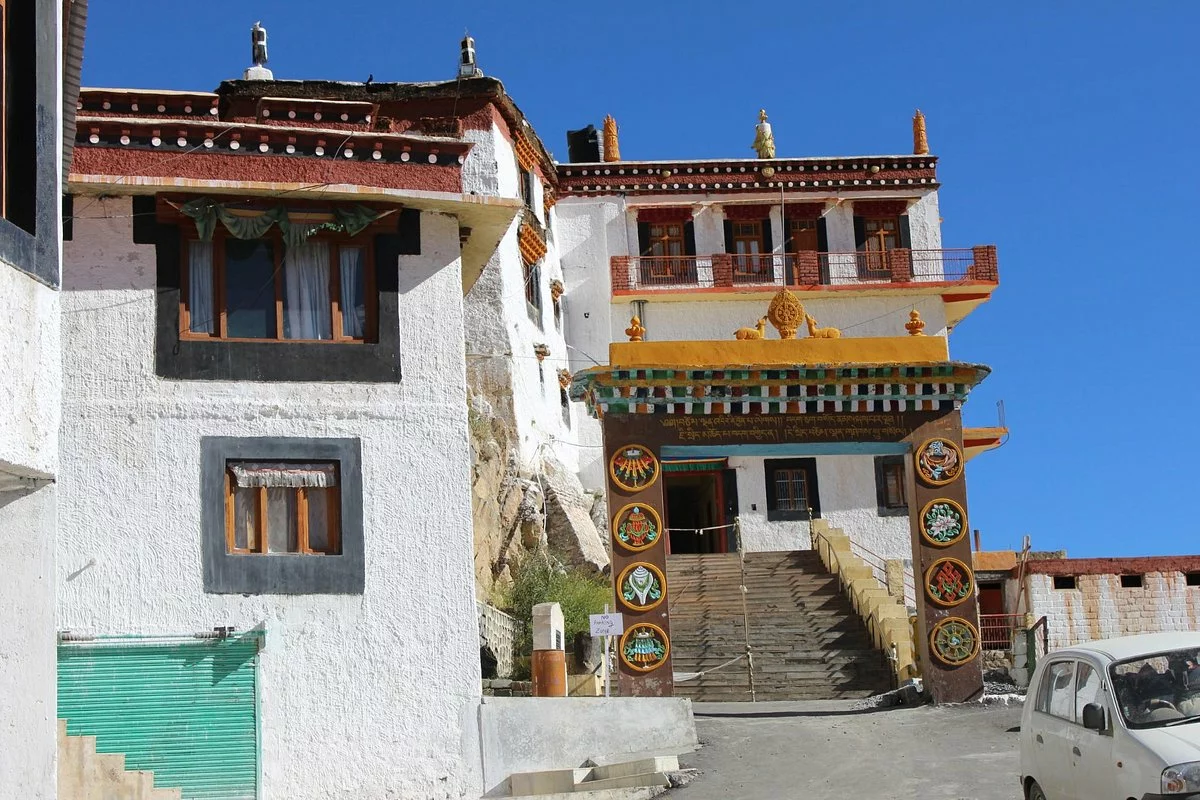
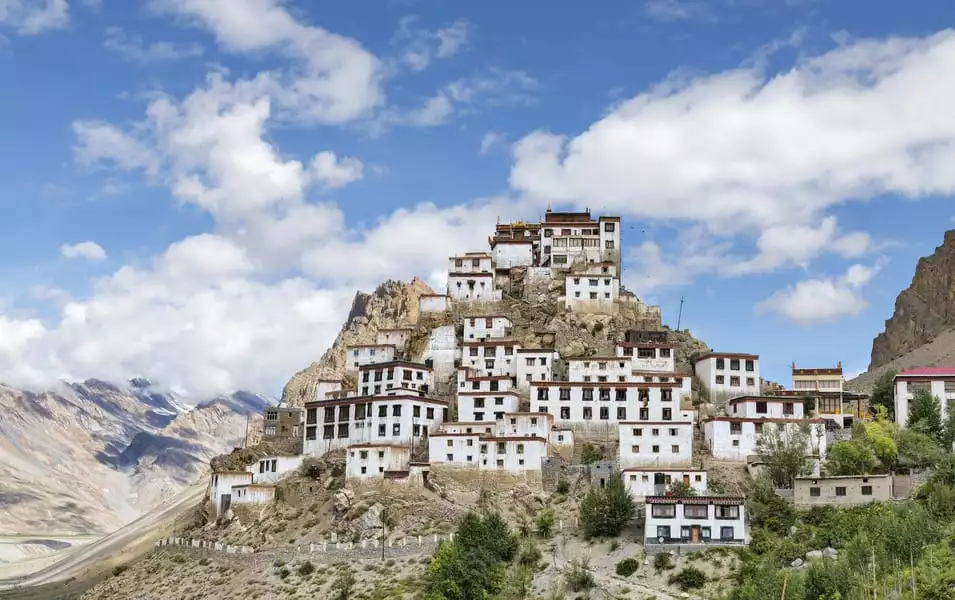
Main temple: The main temple is known as the Du-Khang (‘Du’ means ‘assembly’ and ‘Khang’ means ‘building’), which is beautifully decorated and has small cell-like rooms that have been constructed especially for the monks.
The monastery also has a sizeable collection of musical instruments namely trumpets, cymbals, and drums. This monastery is popular for its rare manuscripts, Thangkas (which are painted Tibetan banners), beautiful murals, stucco images, and unusual wind instruments. Lamas are dressed in vibrant attire and perform traditional dances, with these wind instruments during Key Monastery’s annual summer festival – Cham. 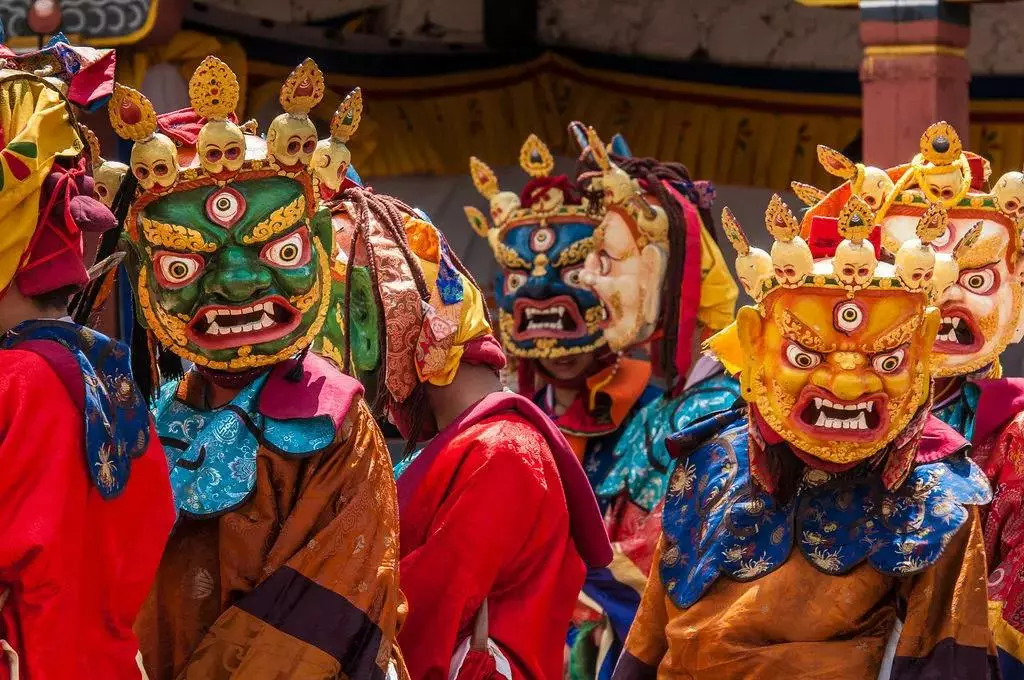
Best Time To Visit Key (or) Kye
The best time to visit Key (or) Kye Monastery is from mid-June to October but if you are visiting this monastery between mid-June to early September, you will be able to visit all the tourist attractions in Spiti Valley. The weather will be nice with warm days and cool nights during the peak tourist season (mid-June to September).
Where To Stay
Accommodation
Accommodation in Key Monastery comes with a reasonable price of ₹ 250, which covers your meal as well. Most of the tourists who visit this monastery, prefer to stay at Kaza because it offers many resorts, hotels, and homestays according to your budget. While visiting the monastery, it is advisable to carry your own food because there are no restaurants or eateries nearby in Kye. One can get refreshed with the herbal butter tea, locally known as ‘Po Cha’ (made from churning tea, salt, and Yak butter which enhances the circulation of oxygen in the body), which is served at the monastery by monks to all the visitors.
How To Reach
Road
You can reach Key Monastery by road either by the scenic Kullu-Manali-Rohtang Pass route or take the alternate route via Shimla-Kinnaur. Since the Kullu-Manali-Rohtang Pass route is sometimes shut down during the monsoon season due to heavy snowfall and landslides but the alternate route is open all the year. Bear in mind that all you need to do is to arrive at Manali or Shimla, no matter which part of the country you are traveling from. From there you will get several buses that take up to Kaza from Manali and Shimla, with an approx. travel duration of 10-12 hrs. From Kaza, you will have to hire your own private cab to reach the Monastery which takes about 40 minutes. The monastery is located around 14 kilometers to the north of Kaza and reaching the monastery involves a steep climb from the car parking which is not suitable for elderly people and small kids.
Train
There are no direct trains available to reach Key Monastery. Although, you can cover a part of your journey by train. The nearest station is Shimla or Chandigarh. After which one must take a bus or a cab to reach this beautiful Monastery.
AIR
If you are taking a flight, then the nearest airports are in Shimla and Buntar (near Manali). The next best option will be the Chandigarh Airport which has far better connectivity.
TREKKING
If you’re an Adventure enthusiast and interested in trekking then one can take up a trek (8.5 Km) from Kaza to Key Monastery. However, one must reach Kaza either by bus, cab, or train.
Thank you for visiting my blog and stay tuned for more updates related to ancient history on my website: Ancientterminus


